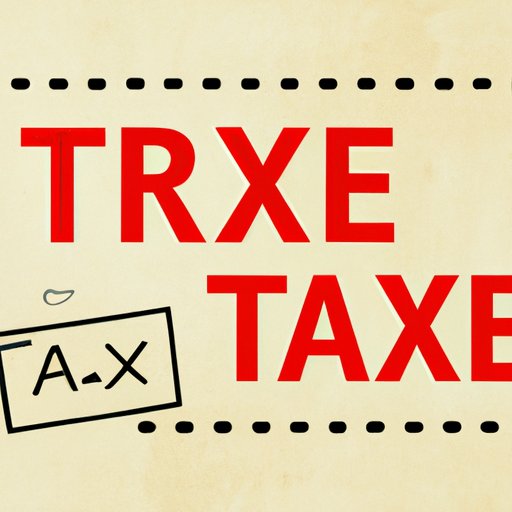
Introduction
Are you curious about tax-free allowances and how they can benefit you? Understanding tax-free allowances is crucial for effective tax planning and maximizing your financial resources. In this guide, we will explore the basics of tax-free allowances, how much you can give tax-free, different types of tax-free allowances, creative strategies for maximizing tax-free gifting, and filing taxes related to tax-free allowances.
Benefits of Tax-Free Allowances: Exploring the Basics
Tax-free allowances refer to certain types of income or gifts that are not subject to income tax. This means that the recipient of the income or gift does not have to pay taxes on it. Tax-free allowances can help you reduce your taxable income and ultimately pay less in taxes. Tax-free allowances include but are not limited to, annual gift tax, baby bonds, and education savings plans.
In order to benefit from tax-free allowances, it is important to understand the basics of how they work, who qualifies for them and the difference between tax-free allowances and tax deductions. Most tax-free allowances are for specific expenses such as healthcare or education rather than for everyday spending.
Getting Down to the Numbers: How Much Can You Give Tax-Free?
The tax-free annual gift exclusion is $15,000 for individuals as per 2021 tax laws. This means that you can give up to $15,000 to someone in a year without having to pay any gift taxes. Married couples can give up to $30,000 per year tax-free through a process known as “gift-splitting.” It’s important to note that if you give a gift that exceeds $15,000, you will have to file a gift tax return with the IRS.
For non-citizens, the limit for tax-free giving is $157,000 per year, granted the gift is not being given to a spouse who is a US citizen. Non-citizens giving to a spouse must abide by the same rules as US citizens.
Here is an example to help illustrate the tax-free gift limit: if you give $12,000 to a friend or family member every year, you will not owe any gift taxes. But if you give $20,000, you will have to file a gift tax return with the IRS, though you likely won’t owe any taxes, yet this can change if you repeat this type of gifting to the same person.
Understanding Different Types of Tax-Free Allowances
There are different types of tax-free allowances in addition to annual gift taxes. Some of the most popular are education and health care expenses. You can contribute money tax-free into a 529 college savings plan until you hit the lifetime limit which is usually around $300,000-$400,000 depending on the state’s plan. Similarly, you can contribute to a health savings account tax-free, however, there are limits placed on daily expenditures.
It’s important to note that tax-free allowances for these expenses come with their own limitations. For instance, education expenses must be related to higher education, and the tax-free allowance is only available for qualified expenses. With medical expenses, there are limits on the amount of money you can contribute annually and how the funds can be used.
Making the Most of Tax-Free Gifting: Creative Strategies and Ideas
There are several creative strategies for maximizing tax-free gifts. One such strategy is spousal gifting. Couples can choose to split their gifts between each other, allowing them to give up to $30,000 annually tax-free. Additionally, charitable contributions allow you to give gifts tax-free while also supporting a worthy cause. Setting up a trust under estate planning gives you flexibility in tax-free gifting even after death.
Consulting with a financial advisor can help you determine the most effective gifting strategy for your situation. A financial advisor can also help you explore other tax-saving strategies, such as creating a Roth IRA for retirement or qualified charitable contributions.
Filing Taxes Made Easy: A Guide to Tax-Free Allowances
Reporting tax-free allowances can sometimes be confusing. However, reporting them is necessary to ensure that you are taking full advantage of tax-free allowances. When filing taxes, be sure to report any tax-free income or gifts you received on your tax return. Also, keep track of documents such as receipts for education and healthcare expenses. These documents could help you claim tax deductions related to these expenses if they exceed the allowable tax-free amount.
Some common mistakes to avoid when filing taxes related to tax-free allowances include failing to report tax-free income or gifts, claiming a tax deduction and tax-free allowance for the same expenses, and not reporting gifts that exceed the annual tax-free gift limit.
Exploring Tax Rules: What You Need to Know About Tax-Free Allowances
It’s important to stay up-to-date with any changes in tax laws related to tax-free allowances. Recent changes included $15,000 in annual exclusion limits for 2021 tax returns. To stay informed, you can consult with a tax advisor or visit official IRS websites.
There are many resources available to help you learn more about tax-free allowances and filing taxes related to them. The IRS provides publications and tax forms related to tax-free allowances and tax-free gifting. These publications offer a wealth of information and can help clarify any doubts.
Conclusion
Tax-free allowances are an important tool for effective tax planning. Understanding the basics of tax-free allowances, the limits, different types, and strategies can help you make informed financial decisions. It’s important to consult with a financial advisor before making any major financial decisions. Remember that tax laws are always changing, so staying up-to-date with these changes will help you take full advantage of tax-free allowances.




